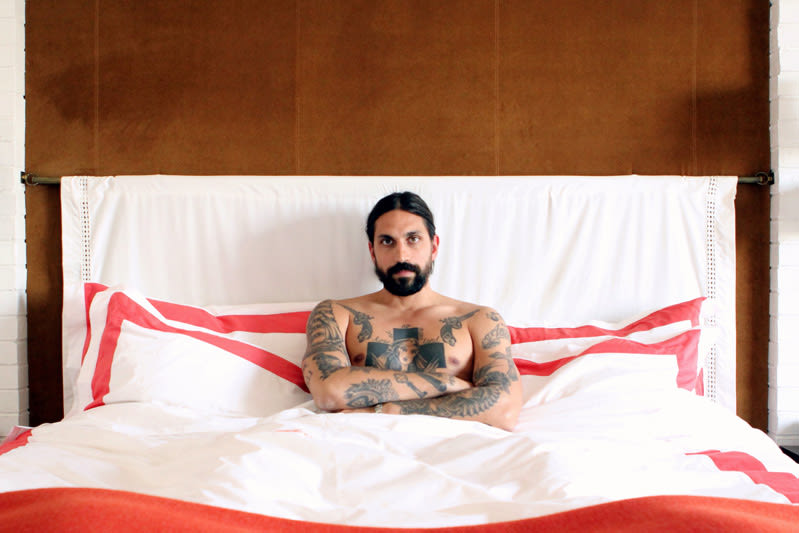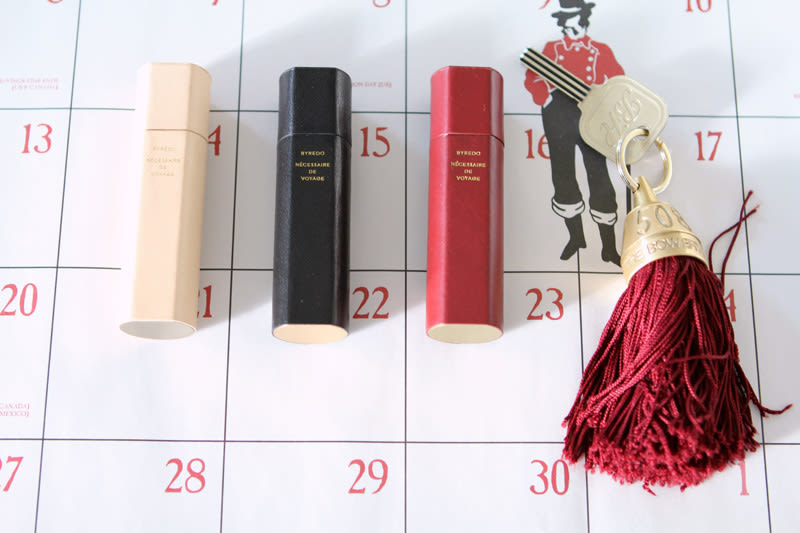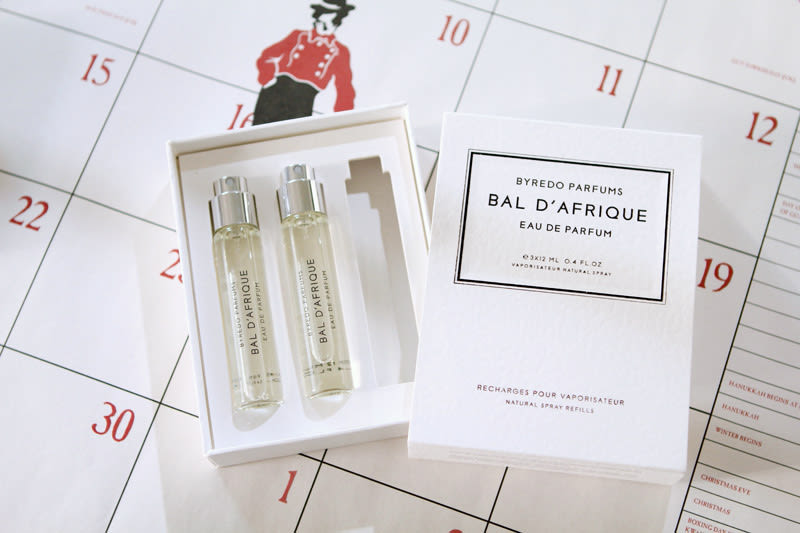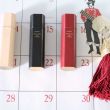'My mother is from India, and my dad is half Scottish, half French Canadian. I was born in Sweden—I lived there as a kid, and then I grew up in a few places. I spent a good portion of the time in Toronto, Canada. So I guess my accent is Swedish…or gypsy. [Laughs] It’s from everywhere. I finished my high school in New York. Then I studied at business school at Ryerson University in Toronto, then switched to politics, then switched to interior design. Then left college to play professional basketball. Then that didn’t really work out so I quit and went to art school in Stockholm. I did a degree in fine arts; I did painting and sculpture, history, photography and a few different things. I really got into painting—acrylics—so that was what I was thinking when I graduated. Then I met a perfumer for the first time. Right after graduating…and that was really my introduction.
I had heard about him in Sweden. He was living in New York, a French guy. He was a fragrance director at one of the perfume houses. I came to him and I had this idea, and he helped me translate it. It was really simple: I put together this creative project that was more about translating specific memories into scents…I was trying to kind of see how literal I could be with the translations. He showed me some stuff and it was very provocative, especially connected to memory. Like, I could get you to smell something and you would be like, ‘ Wow…Troy…ninth grade.’ It could take you places—almost like music—in a very instant way. He showed me in his perfume lab, raw materials like chocolate, or incense, and it would very much be an experience I had. So it started as a creative discussion more about the possibilities—‘can I do this?’ ‘Can I do this?’ Then I started learning about synthetic and raw materials, and I was looking for limitations. I come from an aesthetic world—photography, painting, sculpture—it’s visual, you can touch it. But with scent it was completely different, it was very abstract, but it was evoking all these emotions of places and memories. So, not at all as a commercial endeavor, I created a project for him to translate very specific memories. And he did that. I couldn’t manufacture them in a perfume because it was too difficult, production-wise, with quantities and factories, filtering…the process was tricky. So I made them into candles. I Google-d how to make candles, and I made them myself in the kitchen. I heated the wax to the right temperature; I added the different perfume oils or essences. I was forced to make certain temperature adjustments because some of the essences would evaporate. I bought the glasses at Ikea. The first ones I didn’t make any labels, I just wrote what they were underneath. My friends started wanting them, and then people started calling who wanted them. And then my interest started growing into an obsession…that I wanted to do this full-time. I realized I had to create some type of commerce around it if I wanted to do it full-time. So I had this idea, of a brand… Byredo. It comes from Old English, redolence, which might even be Shakespeare, meaning sweet smelling perfume and reminiscent of redolence or redolent. So I did a short of that…and I was able to register the URL. [Laughs] So I guess I learned how to do business from…everything…if you want to do it yourself, you have to learn. And with the Internet, and people around you, most of the information is available around you if you want it. I think that’s one of the few things I learned at college…how to gather information.
I do have a very different approach from most perfumers…there were things I found out when I first started, that there is a pedigree in the industry. What people like Lili [Barbery-Coulon] expressed in my first press conference in Paris—I guess was maybe a frustration, like ‘What gives you the right?’ Because for one, perfume is very French—there has been this hierarchy in the industry for so long. Which is good because you have incredible talent, and a refinement, but it’s also become stagnant. So for me, it was all about simplifying, for better or for worse. So as opposed to working with fifty, seventy or eighty raw materials for a fragrance, I work with maybe five or ten. There are these beautiful raw materials—I fight with Chanel to buy specific Neroli—and I thought it was a shame to mask them and cover them with different stuff. Maybe it’s something to do with the Swedish ethos, the simplicity…it was just simplifying in terms of creating a clear idea. So when you smell Accord Oud, you get it. You like it or not. M/MINK is like that too: you like it or not. And that was really important for me, in terms of clarity. It could be complex in its simplicity. I want people to get it. The packaging was really the last step for me, because it was so much about simplicity, but it was very exciting to be able to build a world around that. I had a friend draw the typography with me—not the Byredo, but all the labelling that was on the packaging. We drew the whole alphabet and symbols from scratch. And then you have to get a program so you can use it in the computer. It’s cool. And it was because I felt there was nothing that really captured what I was trying to do.
So the first perfume I did was really a memory of my father, from my childhood. I had this idea about specific memories, and even though they were personal I wanted them to tap into some type of… I describe it as a collective memory. The idea itself I thought maybe you could relate to, because your father smelled a certain way, so I wanted to trigger people emotionally with this collective memory. So the first one was my father—he left when I was pretty young, so I had this very clear idea of how he smelled. It took some time thinking about it, and experimenting, but I guess I can visualize it. For me it was about awareness. If I took you in the lab for two weeks, and showed you a spectrum, you would probably be able to show me things that remind you of specific memories. You would be able to develop your vocabulary to create a perfume. And that was the first phase for me, trying to understand the possibilities. Now when I walk down the street I can smell a lot more—dirty laundry, etc. I don’t think it’s a heightened sense of smell, it’s just awareness. So it’s the same for the perfumers—their learning curve is to learn the raw materials they work with, like 2000-3000 raw materials. Because I didn’t go to school for this I had to catch up, but at the same time I didn’t want to become too technical, because I had this possibility to work with two very talented perfumers that do a lot of big work and are immensely creative, and I didn’t want to offset their process. So my idea was to push them in the right direction. I did that with words and raw materials, but also with images, emotion, music and poetry. My briefs were about sitting in a room and getting them to feel something. And hoping I would land close enough to.
So in creating the fragrance for my dad, I was surprised at how easy it was—and afterwards I kind of understand why—but I remember him smelling like this essence of green beans. I described this place where we spent a lot of time in Paris in the 1970’s. So there was a specific time period that was probably a perfume, so the perfumer was able to nail it quite quickly…it was Geoffrey Beene Grey Flannel…and I thought, ‘This is easy, I can do this!’ But it was because there was a specific perfume reference, like if you say, ‘My dad smelled like Old Spice and cigarettes,’ then they can do that for you. So it was green beans, but there was also a softness to it and I think it had more to do with skin tones and soaps and stuff like that. In hindsight, I gave the perfumer a period, a place, and a descriptive element and he put it together. My fragrance was called Green, because that’s what it was, it was green. But when I give a perfume to other people to try, that’s when I realize how subjective it is. I will give something to someone and they will say, ‘Oh—that’s my boyfriend from five years ago,’ and someone else will say, ‘Oh—that reminds me of Mexico.’ It’s so subjective. I haven’t really tried to get you to say, ‘No, it smells like my father.’ For me it’s just been a trigger to start the thinking. I have been working on this fragrance that comes out in the spring, I’ve been working on it for a while, it has a raw material which is an animal note, so it’s quite potent. It smells like a goat—we joke about it, ‘More goat…less goat.’ [Laughs] But it’s a weird raw material by itself; you would never put it on the skin. The animal notes and the animal character, they have this facet of beauty and ugliness at the same time, so that’s quite interesting, because it’s disturbing in a way, but in combination with other raw materials it becomes very beautiful. It’s kind of like the synthetic notes for milk: by itself it’s quite disgusting, but add it in with notes of perfume and humans associate it with comfort…so there are a lot of those weird raw materials that people use.
I made M/MINK with M/M (Paris)—they are art directors and designers, image-makers. They do all the big campaigns that you see. I know Inez and Vinoodh through them; that’s how we met initially and now we’re doing a creative project together. But the M/M (Paris) project started because we had a common friend, I really love their work, and they invited me to their studio one day. And so we got to know each other, started talking. And we decided to work together. They showed me a block of calligraphy ink, which was very specific: it was one of the traditional ones that the Japanese and Korean artists use. I loved the way it smelled, it was very unique, and I said, ‘You know, this could be a good idea.’ That’s exactly what they were feeling. It is something that you either love or hate— M/MINK was about pushing the limits. I used a lot of a synthetic raw material in the top note, called adoxal, which you will find in a few perfumes—especially masculine perfumes of the last ten to fifteen years. But I used almost fifty times the quantity that anybody had ever used it. So there was also an element of comedy or irony, because when perfumers smell it, they would laugh. It’s absurd. It’s like a Lady GaGa version of something—maxed out. So the fans of that have been very specific; there’s an accessories designer in Paris—Yaz Bukey—she is probably the number one fan of that, she goes through, I think, eight bottles since last fall. I’m thinking about doing a big bottle for her. It does have that lovely relationship with the people who wear it…they wear a lot of it, and they probably will for a long time.
If I had to pick a favorite—I don’t know, they all have a special place—but I did, quite early, a fragrance based on a place in India where my mother was born and raised. It’s outside Mumbai, it was a place that was very green, I remember visiting it as a child—it was a picnic spot. And when I came back, semi-grown up, it was massively developed, but it smelled the same. So I became very intrigued, I thought—how is this possible? What has changed, what hasn’t changed? And the part that really resonated with me was incense in the Hindu temples. So I based a fragrance on that, and added certain elements. It is called Encens Chembur, incense from Chembur, which was the name of the place. My mom will wear it. My Dad wears my fragrance, though he tries to get me to change it a little bit for him. [Laughs] I think they find it funny. I moved out in high school to go to boarding school, then I went to college—I was always this jock…then I got into art school in Europe. I think when I first started Byredo, it was a bit of a shock for my mom and dad—especially my dad. Dropping out of school first to play pro-ball, and then doing fragrance. But they get it now, not just brand-wise or commercially, but they get why I do it, which is pretty cool.
Probably my greatest accomplishment—I remember creating this business plan when I started, people saying, ‘What’s your target group, who’s your customer?’ And it said, ‘It’s women and men between the ages of 18 and 85,’ and they said, ‘You cant do that!’ [Laughs] And I said, ‘No, that’s my idea in terms of accessibility, in terms of aesthetics—creating something that is timeless.’ That was a portion of the reason why everything became black and white. I go into stores, in twenty-four countries, and meet my customers, and get a lot of emails: it’s about forty percent men and sixty percent women, from grandmothers, to young models. My girlfriend thinks they are good, but she doesn’t wear any. And I made her one—I have one called Blanche that I made for her. She wore it for three weeks. She is very specific…she doesn’t wear any perfumes. I think I’m getting a good idea on how to turn her, though. But there isn’t really one particular scent that if I smell it on a woman I think, ‘That is really sexy.’ For me it is so much linked to character. I like when women wear a lot of perfume. Or strong perfume. I’m not really into when it’s discreet. So just like with clothing, if somebody wears it well, that becomes beautiful in itself. I feel that with perfume too. People always ask me, ‘What should I wear?’ It is really about finding something that you are comfortable with, that you can wear with a certain confidence. So I think it’s that; the way you wear it as opposed to what you wear. Guys just have to wear perfume. [Laughs] Guys are very spontaneous; they seldom sit down and think about things, so fragrance is very one layer for them. Through Byredo I have gotten guys really interested—to think about it, in terms of what it is, why they wear it and how it makes them feel. I think there’s an evolution there too. But right now, girls are way ahead. Guys just wear whatever. Like, ‘I gotta put shoes on today, because I’m going out; I gotta put perfume on too.’ It’s very functional. They don’t care what they put on as much as they should. But I think they get it when they see this big, straight man in editorials with tattoos. [Laughs] Which somehow makes it okay for a broader range of men and not necessarily just guys who are really into beauty or fragrance.
My first store was Colette in Paris, I just called them, I called Guillaume, head of press; we have a common friend. And then he gave some stuff to Sarah [Lerfel], and they were like, ‘We would like to sell it,’ and I said, ‘Cool!’ and then we started working together. And then I would just kind of pick stores where I thought people got what I was doing. Barneys [New York] is one of my biggest customers. I was a bit nervous when Mark [Lee] and the team came in at Barneys, but they completely got it, better than anybody at Barneys has before. It was very organic. We had these very long discussions about what I was doing and where it was going. So it’s been incredible. I would say it’s because of them I have stayed exclusively with Barneys in the U.S. I think we are the second biggest sellers for them in fragrance. And we opened the stand-alone store in Stockholm a year and a half ago. It gave me a chance to get back into designing. What I found interesting is that I could create an environment that was completely different to fragrances bought today. Because of the quality I chose to manufacture at, pricing became quite high on these fragrances, and I felt like I needed to educate people about what was different about the product. So the stores bare that function in a really interesting way. There are always people sitting; it’s a place where people can go and really learn. The idea is to also open stores in New York and Paris and London. So I’m looking at spaces. I guess Paris would come first because it’s probably easiest because of proximity.
But I’m in a good place right now. I have a new fragrance that just came out, Seven Veils. I really like the idea of doing perfume as a veil, in terms of security, and that feeling of covering yourself in something. There’s this biblical reference I remembered from Catholic school, ‘Salam’s dance of seven veils,’ that I thought was a very extreme tale of seduction. She dances, and she takes off these seven veils, and she is granted this mans head on a plate. So it’s like sex, and seduction and death. It’s a spicy Vanilla; it even has carrot in the top note. And these travel size perfumes will be out early December—it will be every perfume I have done, in travel size. I try not to discriminate. Also these purse cases will be at Barneys before Christmas; they were in development for a long time. I got the leather from different tanneries: one from the leather fair in Bologna; the tan from the place that supplies Louis Vuitton handles—it gets quite dark over time. I had this idea of it being round—because that’s been our geometric shape that we work around—but having one side flat so it won’t slide off the table. And we’ll have an initialing service at the store in Sweden.
It’s difficult to answer the question, ‘Where do you see yourself in five years.’ In regards to the business, if I feel like I get to the point where being independent is limiting me, I might consider selling it, but for now, we are growing at an incredible pace, we are profitable and it’s fun. I have about twelve people that work with me, which I would have never imagined would ever happen in a million years. It’s a bit of a trip. But I have a hard time seeing myself play basketball, even though I did it for fifteen years. It was my life since grade school, in high school and in college. So I am always kind of removed. I never see myself in that role; I’m always kind of on the outside looking at what’s happening, in a weird way.”






